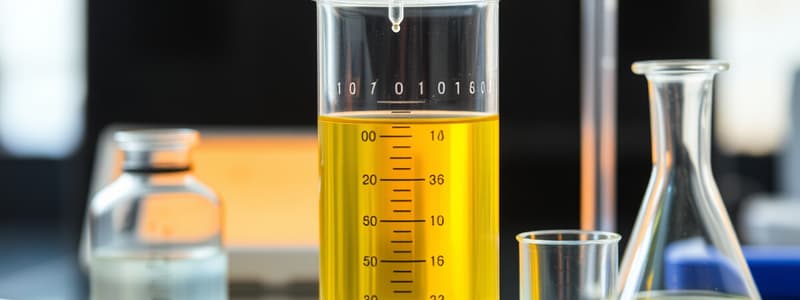Podcast
Questions and Answers
What is the purpose of a titration?
What is the purpose of a titration?
- To determine the mass of a solid sample
- To determine the quantity of a specific substance in a sample (correct)
- To mix two substances completely
- To measure the temperature of a solution
What happens at the equivalence point in a titration?
What happens at the equivalence point in a titration?
- The analyte is in excess
- The pH remains constant
- The pH rises immediately due to excess titrant (correct)
- The solution turns colorless
Which of the following substances is the analyte in the example provided?
Which of the following substances is the analyte in the example provided?
- Acetic acid (correct)
- Water
- Sodium hydroxide
- Sodium acetate
Which factor is NOT necessary for calculating the acetic acid content in the sample?
Which factor is NOT necessary for calculating the acetic acid content in the sample?
During a titration, what is primarily measured to determine when the endpoint has been reached?
During a titration, what is primarily measured to determine when the endpoint has been reached?
What type of solution is the titrant used in titration in the example provided?
What type of solution is the titrant used in titration in the example provided?
What is the primary purpose of titration in volumetric analysis?
What is the primary purpose of titration in volumetric analysis?
Which of the following statements best describes a titrant?
Which of the following statements best describes a titrant?
What type of equipment is a pipette used for in volumetric analysis?
What type of equipment is a pipette used for in volumetric analysis?
Which of the following is NOT a requirement for a reaction to be suitable for volumetric analysis?
Which of the following is NOT a requirement for a reaction to be suitable for volumetric analysis?
What does the term 'aliquot' refer to in volumetric analysis?
What does the term 'aliquot' refer to in volumetric analysis?
Which glassware is specifically used to prepare and store a standard solution?
Which glassware is specifically used to prepare and store a standard solution?
What characteristic of a reaction ensures that it is unequivocal in volumetric analysis?
What characteristic of a reaction ensures that it is unequivocal in volumetric analysis?
In volumetric analysis, what is the significance of the term 'neutralization' during titration?
In volumetric analysis, what is the significance of the term 'neutralization' during titration?
What is the role of the burette in a titration experiment?
What is the role of the burette in a titration experiment?
What does the term equivalence point refer to in a titration?
What does the term equivalence point refer to in a titration?
Which of the following prerequisites must be fulfilled for a successful titration?
Which of the following prerequisites must be fulfilled for a successful titration?
What is the endpoint in the context of an acid-base titration?
What is the endpoint in the context of an acid-base titration?
Why must the titrant concentration and volume used be known very accurately?
Why must the titrant concentration and volume used be known very accurately?
What is the significance of being able to add titrant in small quantities during titration?
What is the significance of being able to add titrant in small quantities during titration?
Which of these pieces of equipment is not standard for performing a titration?
Which of these pieces of equipment is not standard for performing a titration?
What is a key point in achieving a good titration result?
What is a key point in achieving a good titration result?
What is the primary purpose of a stopcock in a manual burette?
What is the primary purpose of a stopcock in a manual burette?
Which of the following is an application of titration in the food and beverage industry?
Which of the following is an application of titration in the food and beverage industry?
Which type of titration is commonly used for measuring the acidity in oils?
Which type of titration is commonly used for measuring the acidity in oils?
Which statement about redox titrations is true?
Which statement about redox titrations is true?
In which application of titration would you find the determination of water content?
In which application of titration would you find the determination of water content?
What is a common application of titration in the petrochemical industry?
What is a common application of titration in the petrochemical industry?
Which of the following types of titration involves the formation of a precipitate?
Which of the following types of titration involves the formation of a precipitate?
What is an application of titration in environmental testing?
What is an application of titration in environmental testing?
Flashcards are hidden until you start studying
Study Notes
Volumetric Analysis and Titration
- Titration involves adding a known volume of a titrant to an unknown concentration solution until neutralization occurs, often indicated by a color change.
- Known as titrimetric analysis, volumetric analysis focuses on quantifying a solution using accurate volume measurements.
Requirements for Volumetric Analysis
- Cleanliness: Requires extremely clean glassware.
- Precise Measurements: Requires careful measurement and recording of data.
- Reaction Criteria: Reactions should be selective, fast, complete, and unambiguous.
Key Components of Volumetric Analysis
- Volumetric Flask: Used to prepare and store standard solutions.
- Pipette: Delivers an accurate aliquot of the solution.
- Burette: Delivers and measures the titrant volume accurately.
- Aliquot: An accurately known volume from the pipette.
- Titrant: Solution with known concentration.
- Titrate: The solution being analyzed to determine its concentration.
- Titre: The total volume from the burette required to reach the endpoint.
Titration Process
- Analyte concentration is determined by adding a titrant until a complete reaction occurs, exemplified by the reaction of acetic acid with sodium hydroxide.
- Practical steps include diluting the sample and monitoring pH changes until reaching the equivalence point where all analyte has reacted.
Key Terms
- Equivalence Point: Where the moles of titrant equal the moles of analyte.
- Endpoint: Defined by the indicator's color change during titration.
- Titration must achieve accurate reagent delivery and reliable volume measurement.
Applications of Titration
- Chemical Industry: Analyzing water content in solvents and acid values in polymers.
- Food and Beverage: Measuring acid, vitamin content, and chloride levels.
- Electroplating: Quantifying metal content in baths.
- Pharmaceuticals: Determining water content and purity of active ingredients.
- Petrochemical Analysis: Analyzing acid and base numbers in oils.
- Environmental Studies: Measuring water hardness and residual chlorine.
Types of Titration
- Acid-Base Titrations: Measure the neutralization of acids and bases.
- Precipitation Titrations: Analyze reactions leading to the formation of a precipitate.
- Redox Titrations: Focus on electron transfer reactions.
- Complexometric Titrations: Involve the formation of complexes during the titration process.
Studying That Suits You
Use AI to generate personalized quizzes and flashcards to suit your learning preferences.




